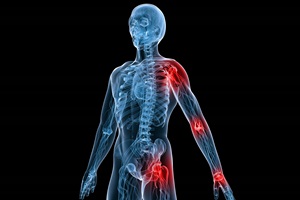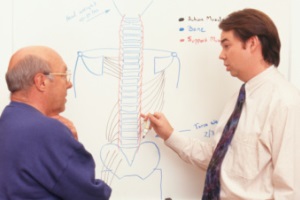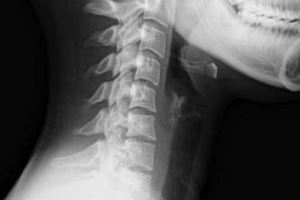What is “Referred Pain”?
 “Referred pain” can be a perplexing phenomenon for anyone who experiences it. Referred pain is what happens when you feel pain in an area of your body that is not actually the original source of the pain signals. The most common example of referred pain is when pain is felt in the left arm, neck or jaw of a person suffering a heart attack, while they often have no feelings of pain in the chest area itself.
“Referred pain” can be a perplexing phenomenon for anyone who experiences it. Referred pain is what happens when you feel pain in an area of your body that is not actually the original source of the pain signals. The most common example of referred pain is when pain is felt in the left arm, neck or jaw of a person suffering a heart attack, while they often have no feelings of pain in the chest area itself.
It’s important to note that referred pain is different from radiating pain, in which the pain felt in one area travels down a nerve, causing pain along the length of the nerve. This is often the case with sciatica, where pain originates in the lower back and radiates down the leg.
Researchers are still not exactly sure what causes referred pain. Some experts believe that it is due to a mix-up in nerve messaging. The central nervous system (CNS) is constantly receiving a barrage of different messages from different parts of the body. These messages may get mixed up somewhere along the path between the place where the irritated nerve is signaling and the spinal cord or brain where pain signals are processed. With an extensive network of interconnected sensory nerves that serve the same region of the body, such as the nerves of the lower back, thighs and hips, it may be more common for signals to get mixed up than you might imagine.
Although referred pain is usually felt as painful, it can also cause feelings of numbness, tingling or the sensation of pins and needles. Another example of referred pain is a tension headache, in which headache pain is due to an irritation of the nerves in the neck.
Referred pain tends not to cross sides of the body. In other words, if the pain signals are originating in the liver or gallbladder (which are on the right side of the body), you may feel pain in your right shoulder. If the signals originate in the pancreas (on the left of the body), you may feel pain in your left shoulder, etc.
Chiropractic adjustments can address the source of the referred pain, leading to long-term pain relief. Nerves in the area of the spinal cord that are irritated due to a spinal misalignment (subluxation) can be a cause of referred pain. When your chiropractor adjusts your spine, he or she removes the source of irritation, thus providing relief. Dr. Oblander is a Billings Chiropractor who is very knowledgeable about which tests can be performed to determine the underlying cause of your pain (whether direct or referred), and can treat it accordingly. If you have questions or want to seek chiropractic treatment, be sure to give us a call at Oblander Chiropractic: 406-652-3553.


 According to the National Institutes of Health and Dr. Michael S. Wilkes of the Western Journal of Medicine, “Despite a plethora of research intended to guide physicians in their management of back pain, physicians still hold strong non-evidence based beliefs dating back to the 19th century.” What beliefs is Dr. Wilkes referring to? He’s talking about the long-held conventional wisdom that says bed rest is one of the best ways to treat back pain.
According to the National Institutes of Health and Dr. Michael S. Wilkes of the Western Journal of Medicine, “Despite a plethora of research intended to guide physicians in their management of back pain, physicians still hold strong non-evidence based beliefs dating back to the 19th century.” What beliefs is Dr. Wilkes referring to? He’s talking about the long-held conventional wisdom that says bed rest is one of the best ways to treat back pain. According to the National Institutes of Health and Dr. Michael S. Wilkes of the Western Journal of Medicine, “Despite a plethora of research intended to guide physicians in their management of back pain, physicians still hold strong non-evidence based beliefs dating back to the 19th century.” What beliefs is Dr. Wilkes referring to? He’s talking about the long-held conventional wisdom that says bed rest is one of the best ways to treat back pain.
According to the National Institutes of Health and Dr. Michael S. Wilkes of the Western Journal of Medicine, “Despite a plethora of research intended to guide physicians in their management of back pain, physicians still hold strong non-evidence based beliefs dating back to the 19th century.” What beliefs is Dr. Wilkes referring to? He’s talking about the long-held conventional wisdom that says bed rest is one of the best ways to treat back pain. America’s roads have become far safer across the past three decades. By just about any measure, travelers are much less likely to be injured or killed in a motor vehicle accident than they were in the late 1980s and early 1990s. And this is true even though we’re driving more miles each year!
America’s roads have become far safer across the past three decades. By just about any measure, travelers are much less likely to be injured or killed in a motor vehicle accident than they were in the late 1980s and early 1990s. And this is true even though we’re driving more miles each year! Headaches are one of the most common types of pain that people experience on a regular basis. Researchers estimate that nine out of ten Americans suffer from headache pain at some point. 95% of women and 90% of men have had at least one in the past 12 months. And for about 45 million of us, those headaches are chronic.
Headaches are one of the most common types of pain that people experience on a regular basis. Researchers estimate that nine out of ten Americans suffer from headache pain at some point. 95% of women and 90% of men have had at least one in the past 12 months. And for about 45 million of us, those headaches are chronic.
 If you’re suffering from acute or chronic back pain–whether it’s been caused by an injury or some type of medical condition–chances are that you’re more interested in finding relief NOW than learning about the many different types of doctors who are part of the healthcare community. But the simple truth is that different types of doctors tend to approach their work in particular ways because of basic differences in their training and clinical experience. This means that it’s worthwhile for a back pain patient to understand at least a little bit about how a physician’s chosen discipline can influence his or her perspective and priorities when it comes to treatment.
If you’re suffering from acute or chronic back pain–whether it’s been caused by an injury or some type of medical condition–chances are that you’re more interested in finding relief NOW than learning about the many different types of doctors who are part of the healthcare community. But the simple truth is that different types of doctors tend to approach their work in particular ways because of basic differences in their training and clinical experience. This means that it’s worthwhile for a back pain patient to understand at least a little bit about how a physician’s chosen discipline can influence his or her perspective and priorities when it comes to treatment.